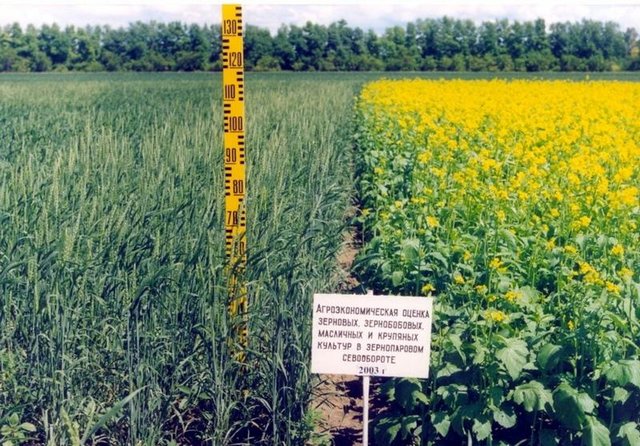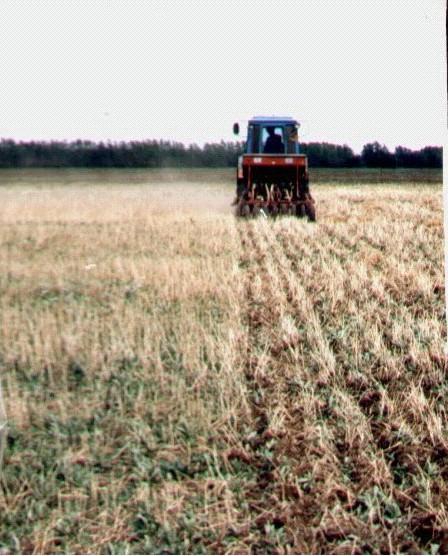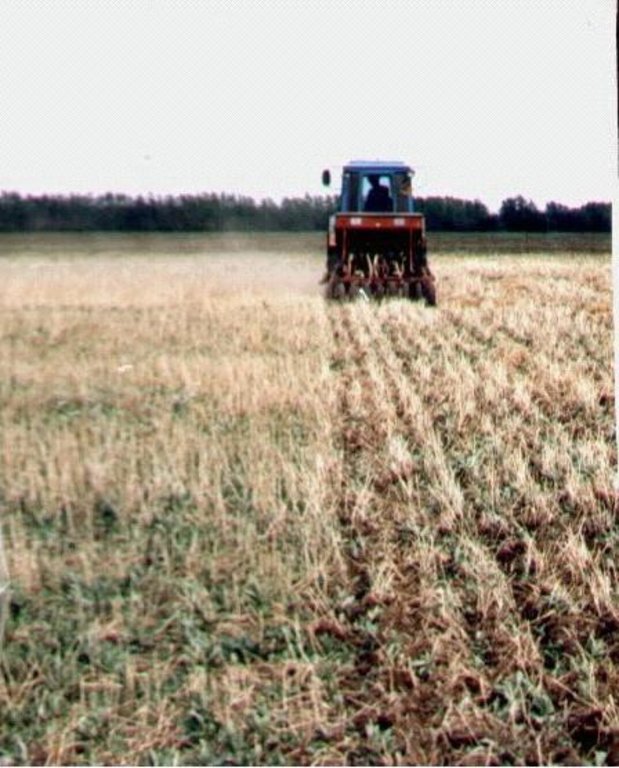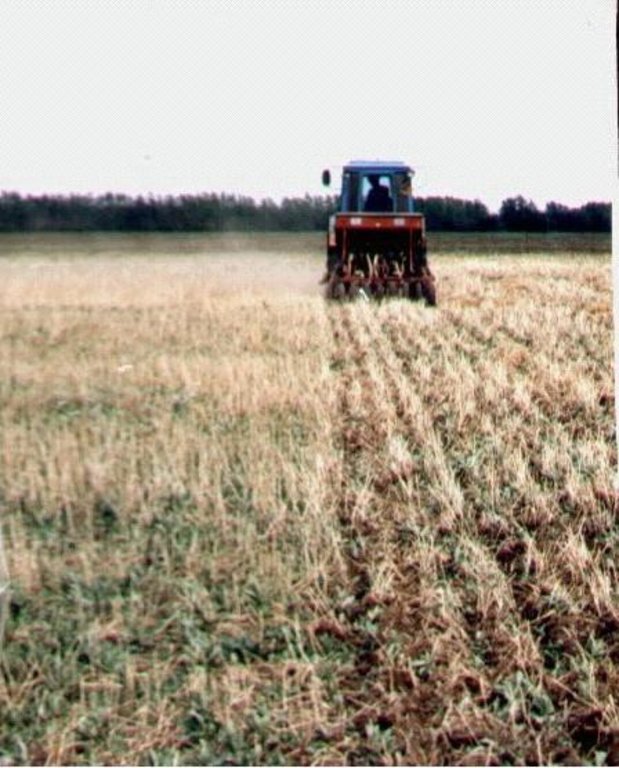Выращивание культур по стерневому фону [Казахстан]
- Создание:
- Обновить:
- Составитель: Ervin Gossen
- Редактор: Hayot Ibrakhimov
- Рецензенты: Rima Mekdaschi Studer, Fabian Ottiger
approaches_2363 - Казахстан
Просмотреть разделы
Развернуть все Свернуть все1. Общая информация
1.2 Контактные данные специалистов и организаций, участвующих в описании и оценке Подхода
1.3 Условия, регламентирующие использование собранных ВОКАТ данных
Составитель и ответственный/-ые специалист(-ы) согласны с условиями, регламентирующими использование собранных ВОКАТ данных:
Да
1.4 Ссылка (-и) на Анкету (-ы) по Технологиям УЗП

Почвозащитная минимальная технология обработки почвы и посева [Казахстан]
Минимальная обработка почвы под возделывание зерновых культур (вторая и третья культура после пара).
- Составитель: Ervin Gossen
2. Описание Подхода УЗП
2.1 Краткое описание Подхода
Стерневой посев для возделывания зерновых культур (яровой пшеницы).
2.2 Подробное описание Подхода
Подробное описание Подхода:
Цели / задачи: Посев по стерне включает в себя следующее:
Весной, в период с 15 по 25 мая, без специальной подготовки, то есть по стерне, проводится посев зерновых культур.
Посев выполняется стерневой сеялкой.
Глубина заделки семян — 6–8 см.
Норма высева — 180 кг/га.
Урожайность при посеве по стерне составляет 11,5 ц/га.
Данный подход предотвращает ветровую и водную эрозию, способствует накоплению влаги в почвенном покрове и повышению содержания органического вещества. Проблема деградации почв особенно остра в Северном Казахстане — зоне зернового земледелия. За период длительного распашки целинных земель содержание гумуса снизилось на 5–20 % и более. Из 4,3 млрд тонн гумуса пахотного слоя (0–25 см) безвозвратно утрачено 1,2 млрд тонн, или 28,3 %, в результате минерализации органического вещества, выноса с урожаем, водной и ветровой эрозии.
В 1970-е годы в Казахстане была разработана и внедрена почвозащитная система земледелия, благодаря которой эрозия была остановлена, а урожайность значительно возросла. До внедрения почвозащитной системы урожайность в Северном Казахстане составляла 5–7 ц/га, после внедрения — возросла до 12–15 ц/га. Одним из ключевых элементов почвозащитной системы является посев по стерне.
В условиях Казахстана вспашка и посев должны проводиться с сохранением стерни на паровом поле один раз за севооборот. Это способствует сохранению и рациональному использованию растительных остатков и влаги, снижению производственных затрат, а также повышению урожайности зерновых культур.
2.3 Фотографии, иллюстрирующие Подход
2.5 Страна/ регион/ место, где применялся Подход
Страна:
Казахстан
Административная единица (Район/Область):
Северный Казахстан
2.6 Даты начала и окончания реализации Подхода
Год начала реализации:
1976
2.7 Тип Подхода
- традиционная/ местная система землепользования, используемая коренным населением
2.8 Каковы цели/ задачи Подхода
Подход был сосредоточен исключительно на УУЗР (гербициды, влагонакопление, севооборот).
Предотвращение ветровой и водной эрозии почв, повышение урожайности зерновых культур в степной зоне Казахстана, сохранение влагонакопления.
Подход УУЗР решал следующие проблемы: предотвращение водной и эрозионной эрозии на пахотных землях.
2.9 Условия содействующие применению Технологии/ Технологий в рамках Подхода или затрудняющие его
Социальные/ культурные/ религиозные нормы и ценности
- затрудняют
Обработка с помощью подхода УУЗР: Нехватка финансовых активов.
Наличие/ доступность финансовых ресурсов и услуг
- затрудняют
Сотрудничество фермерских хозяйств.
Обработка с использованием подхода УУЗР
Нормативно-правовая база (землевладение, права на земле- и водопользование)
- содействуют
Существующие права собственности и права пользования землёй / водой в умеренной степени способствовали внедрению данного подхода: наличие прав на землю позволяет землепользователям оперативнее принимать решения о его применении.
- затрудняют
Старый изношенный парк сельскохозяйственной техники.
Обработка с использованием подхода УУЗР
Осведомленность в области УЗП, доступность технической поддержки
- затрудняют
Кооперативный подход фермеров к совместному использованию техники.
Обработка с использованием подхода УУЗР
3. Участие и распределение ролей заинтересованных сторон
3.1 Заинтересованные стороны, участвующие в реализации Подхода и их роли
- местные землепользователи/ местные сообщества
Работающими землепользователями были в основном мужчины (Объединение отдельных хозяйств, где основной объем сельскохозяйственных работ выполняют мужчины)
В основном участвовали мужчины. Технологические циклы зернового хозяйства обслуживаются мужчинами.
- местные власти
- государственные власти (отвечающие за планирование или принятие решений)
Органы местного самоуправления
3.2 Участие местных землепользователей/ местных сообществ на разных стадиях реализации Подхода
| Участие местных землепользователей/ местных сообществ | Перечислите участников и опишите их вовлеченность | |
|---|---|---|
| инициирование/ мотивация | пассивное | Публичные собрания; Встречи фермеров |
| планирование | пассивное | семинары; Популяризация подхода |
| выполнение | самоорганизация | ответственность за основные шаги; Личная заинтересованность фермеров |
| мониторинг/ оценка | нет | |
| Research | нет |
3.4 Принятие решений по выбору Технологии/ Технологий УЗП
Укажите, кто принимал решение по выбору применяемой Технологии/ Технологий:
- преимущественно специалисты по УЗП после консультаций с землепользователями
Поясните:
Необходимость сохранения плодородия земель и борьбы с эрозией.
Решения о методе внедрения технологии УУЗР принимались преимущественно землепользователями при поддержке специалистов по УУЗР. Введение
4. Техническая поддержка, повышение компетенций и управление знаниями
4.2 Консультационные услуги
Есть ли у землепользователей возможность получать консультации?
Да
Укажите, где именно оказываются консультационные услуги:
- на полях землепользователей
Описание/ комментарий:
Рекомендации по системе ведения сельского хозяйства; Ключевые элементы: Распространение методических пособий, Распространение справочников по агромелиоративным мероприятиям; 1) Консультационные услуги осуществлялись посредством: Личного общения. 2) Целевые группы для распространения: Землепользователи; Мероприятия: Семинары, беседы, совместное ознакомление с подходом.
Консультационные услуги недостаточны для обеспечения непрерывности мероприятий по охране земель; Государственные структуры и службы обучения отсутствуют.
4.3 Институциональная (организационная) поддержка
В ходе реализации Подхода были ли организованы новые институциональные структуры или поддержаны уже существующие?
- да, существенно
Укажите уровень, на котором структуры были укреплены или вновь созданы:
- местные
Укажите тип поддержки:
- оборудование
4.4 Мониторинг и оценка
Являются ли мониторинг и оценка частью Подхода?
Да
Комментарии:
Биофизические параметры регулярно отслеживались путём наблюдений.
Экономические / производственные показатели регулярно отслеживались путём наблюдений.
Экологические параметры регулярно отслеживались путём наблюдений.
В результате мониторинга и оценки в подход были внесены незначительные изменения:
методологический подход остался без изменений, корректировки коснулись технологической части — была усовершенствована конструкция сеялки.
4.5 Научные исследования
Были ли научные исследования частью Подхода?
Да
Укажите темы исследований:
- экономика / маркетинг
- экология
- технология
Напишите подробнее и назовите тех, кто выполнял исследования:
1. Подбор сортов зерновых культур. 2. Разработка и создание техники (сеялки СЗС-2). 3. Разработка рекомендаций по ведению зернового хозяйства в условиях засушливой степи и степной зоны.
Исследования проводились как на станции, так и в хозяйстве.
5. Финансирование и внешняя материальная поддержка
5.1 Годовой бюджет мероприятий по УЗП в рамках Подхода
Если точный годовой бюжет неизвестен, укажите примерный диапазон затрат:
- < 2000
Комментарий (например, основные источники финансирования/ ключевые доноры):
Расходы на подход были покрыты следующими донорами: правительство (национальное): 100,0%
5.2 Финансирование и внешняя материальная поддержка, предоставляемая землепользователям
Предоставлялась ли землепользователям финансовая/ материальная поддержка для применения Технологии /Технологий?
Да
5.3 Субсидии на отдельные затраты (включая оплату труда)
- оборудование
| Укажите, какие ресурсы были субсидированы | В какой степени | Опишите субсидии подробнее |
|---|---|---|
| техника | профинансированы частично | |
5.4 Кредитование
Предоставлялись ли в рамках Подхода кредиты на мероприятия УЗП?
Нет
6. Анализ влияния и заключительные положения
6.1 Влияние Подхода
Сумел ли Подход помочь землепользователям внедрить и поддерживать технологии УЗП?
- Нет
- Да, немного
- Да, умеренно
- Да, существенно
Такой подход значительно уменьшает эрозию почвы.
Приняли ли этот подход другие землепользователи/проекты?
- Нет
- Да, немного
- Да, умеренно
- Да, существенно
Данный подход является элементом системы защиты почв при минимальной обработке земли.
6.3 Долгосрочная устойчивость мероприятий в рамках Подхода
Могут ли землепользователи самостоятельно (без внешней поддержки) продолжать применение того, что было реализовано в рамках Подхода?
- да
6.4 Сильные стороны/ преимущества Подхода
| Сильные стороны/ преимущества/ возможности по мнению землепользователей |
|---|
| Поддержание гарантированного урожая (Как сохранить/укрепить это преимущество: то же самое) |
| Поддержание гарантированных доходов (Как сохранить/укрепить это преимущество: то же самое) |
|
Повышение плодородия почв (Как поддерживать / усиливать это преимущество: регулярное применение почвозащитных технологий). |
| Снижает опасность проявления водной и ветровой эрозии (Как поддерживать / усиливать это преимущество: регулярное применение почвозащитных технологий). |
| Сильные стороны/ преимущества/ возможности по мнению составителя или других ключевых специалистов |
|---|
|
Обеспечивает гарантированный урожай (Как сохранить / усилить это преимущество: экологическое просвещение и обучение) |
|
Повышение плодородия почв (Как сохранить / усилить это преимущество: расширять площади применения почвозащитного подхода) |
| Уменьшение площади эродированных земель (Как сохранить / усилить это преимущество: расширять площади применения почвозащитного подхода) |
6.5 Слабые стороны/ недостатки Подхода и пути их преодоления
| Слабые стороны/ недостатки/ риски по мнению землепользователей | Возможные пути их преодоления/снижения? |
|---|---|
| Экологические ограничения почвозащитного подхода | Необходимы инвестиции |
| Слабые стороны/ недостатки/ риски по мнению составителя или ответственных специалистов | Возможные пути их преодоления/снижения? |
|---|---|
| Нехватка средств у мелких фермеров | Кооперация фермерских хозяйств и привлечение инвестиций |
7. Справочные материалы и ссылки
7.1 Методы сбора/источники информации
- выезды на места, полевые обследования
- опросы землепользователей
7.2 Ссылки на опубликованные материалы
Название, автор, год публикации, ISBN:
Gossen E.F. Without rotation of layer, Almaty 2000 ySoil-protective agriculture Baraev A.I., Moscow 'Floc' 1975 y
Где опубликовано? Стоимость?
SPC for Grain Husbandry of the Baraev???s name 15$SPC for Grain Husbandry Baraev A.I. 10$
Название, автор, год публикации, ISBN:
Soil-protective agriculture Baraev A.I., Moscow 'Floc' 1975
Где опубликовано? Стоимость?
SPC for Grain Husbandry Baraev A.I. 10$
Ссылки и модули
Развернуть все Свернуть всеСсылки

Почвозащитная минимальная технология обработки почвы и посева [Казахстан]
Минимальная обработка почвы под возделывание зерновых культур (вторая и третья культура после пара).
- Составитель: Ervin Gossen
Модули
Нет модулей




